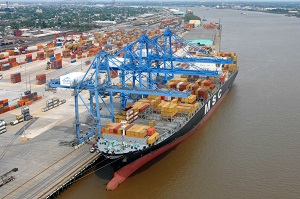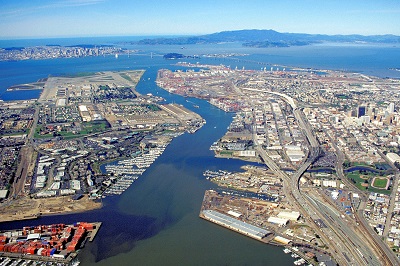U.S. Ports Move On From Labor Dispute
Import cargo volume at the U.S.’s major retail container ports is returning to normal levels as officials prepare to count votes on ratification of a new West Coast labor agreement, but industry is calling for more long-term development to secure port activity into the future.
The Pacific Maritime Association and the International Longshore and Warehouse Union tentatively agreed on a five-year contract in February. While ILWU leadership has recommended that members vote for ratification, votes won’t be counted until May 22. The lack of a contract and operational issues led to crisis-level congestion at West Coast ports after the previous agreement expired last July.
“Dockworkers and management made a massive push to clear the backlog of cargo over the past several weeks and West Coast ports are getting back to normal despite concerns such as the Teamster picketing seen in Los Angeles and Long Beach earlier this month,” National Retail Federation Vice President for Supply Chain and Customs Policy Jonathan Gold said.
“We hope to see this month’s ratification vote go smoothly and then settle into a long period of efficient, dependable operations before we have to think about contract talks again. But there are still plenty of other issues impacting congestion that the ports need to work through.”
Supply Chain Changed
Congestion at West Coast ports has prompted many importers to shift their cargo elsewhere, prompting speculation on how long the shift might last. West Coast ports handled 55 percent of cargo this January, down from 64 percent during the same month in 2014, while East Coast ports handled 45 percent, up from 36 percent.
 “Importers and exporters are reviewing their supply chain plans for the future, and not necessarily in favor of the West Coast,” Hackett Associates Founder Ben Hackett said. “Looking on the practical side, a number of factors favor a return to the West Coast.”
“Importers and exporters are reviewing their supply chain plans for the future, and not necessarily in favor of the West Coast,” Hackett Associates Founder Ben Hackett said. “Looking on the practical side, a number of factors favor a return to the West Coast.”
Hackett said sending ships from Asia to the East Coast is more expensive than the West Coast, takes longer, and results in higher expenses to move the cargo to Midwest distribution centers by rail. In addition, importers have significant investments in West Coast distribution centers that would not easily be abandoned.
Clearing the Backlog
According to an analysis from the monthly Global Port Tracker report released by the National Retail Federation and Hackett Associates, ports covered by Global Port Tracker handled a record-high 1.73 million TEU in March.
The ports covered in the analysis are Los Angeles/Long Beach, Oakland, Seattle and Tacoma on the West Coast; New York/New Jersey, Hampton Roads, Charleston, Savannah, Port Everglades and Miami on the East Coast, and Houston on the Gulf Coast.
Driven up by a sudden surge of backlogged cargo from vessels that were sitting at anchor waiting to be discharged after the labor dispute ended, the number was up 44.9 percent from February and 33.1 percent from March 2014.
April was estimated at 1.55 million TEU, up 8.1 percent from 2014. May is forecast at 1.56 million TEU, up 5.4 percent; June at 1.53 million TEU, up 3.7 percent; July at 1.57 million TEU, up 5.1 percent; August at 1.58 million TEU, up 3.9 percent, and September at 1.6 million TEU, up 1.1 percent.
The first half of 2015 is forecast at 8.8 million TEU, an increase of six percent over the same period last year.
Excessive Number of Large Vessels
Hackett said the strong increases in volume are coming as shipowners are launching an excessive number of large new vessels that could lead to a price war on shipping rates.
“This upsets the supply/demand balance,” Hackett said. “There is not enough demand to justify this level of capacity increase. Expect rates on both coastal services to fall to all-time lows.”
A Call for Infrastructure Modernization
Thousands of stakeholders in Washington, D.C., and across the country are coming together for Infrastructure Week, May 11-15 where they will highlight the critical importance of investing in and modernizing America’s infrastructure, including its seaports and their land- and water-side connections.
 “Seaport activity accounts for a quarter of the U.S. economy and it’s time to build America’s 21st century transportation infrastructure to support continued economic growth and deliver prosperity to all Americans,” said Kurt Nagle, president and CEO of the American Association of Port Authorities (AAPA).
“Seaport activity accounts for a quarter of the U.S. economy and it’s time to build America’s 21st century transportation infrastructure to support continued economic growth and deliver prosperity to all Americans,” said Kurt Nagle, president and CEO of the American Association of Port Authorities (AAPA).
Congress plays a critical role ensuring that the U.S. remains a global economic powerhouse. AAPA strongly supports several vital programs important to seaports that are on the congressional schedule over the next few weeks. These include: Trade Promotion Authority (TPA) legislation, long-term reauthorization of surface transportation legislation that includes a strong freight program and reauthorization of the Export-Import Bank to encourage more U.S. exports.
“Given seaports’ essential role in trade and transportation, AAPA urges Congress to prioritize investments in port-related infrastructure. Such investments pay huge dividends in terms of sustainable job and economic growth and tax revenues,” said Nagle.
AAPA has a number of funding priorities that will help the country build and maintain a 21st century transportation infrastructure, including:
• the U.S. Department of Transportation’s Transportation Infrastructure Generating Economic Recovery (TIGER) program, which helps improve port infrastructure as well as water, rail and road connections to seaports;
• the U.S. Army Corps of Engineers coastal navigation program to modernize and maintain U.S. harbors for efficient importing and exporting of goods;
• the U.S. Department of Homeland Security’s Port Security Grants program and the U.S. Environmental Protection Agency’s Diesel Emission Reductions Act (DERA) environmental grants, both of which keep seaports sustainable and help safeguard local communities.
In the spirit of Infrastructure Week and in the interest of building and sustaining 21st century transportation infrastructure, AAPA is urging Congress to take action on these priorities.
Tax Victory
The AAPA celebrated a major funding victory at the end of April with the passage of the U.S. House of Representative’s 2016 Energy and Water Appropriations bill and two included amendments.
The bill and accompanying amendments increase funding for Harbor Maintenance Tax to 36.3 million, which will help achieve a 2016 port improvement target of $1.25 billion. This is a major milestone for U.S. ports hoping to improve and maintain existing infrastructures. In total, AAPA member ports claim they will need $28.9 billion by 2025 in order to improve the road, rail and tunnel systems that support U.S. port operations.
